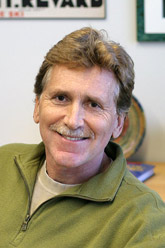
Handy Links
SLAC News Center
SLAC Today
- Subscribe
- Archives: Feb 2006-May 20, 2011
- Archives: May 23, 2011 and later
- Submit Feedback or Story Ideas
- About SLAC Today
SLAC News
Lab News
- Interactions
- Lightsources.org
- ILC NewsLine
- Int'l Science Grid This Week
- Fermilab Today
- Berkeley Lab News
- @brookhaven TODAY
- DOE Pulse
- CERN Courier
- DESY inForm
- US / LHC
SLAC Links
- Emergency
- Safety
- Policy Repository
- Site Entry Form

- Site Maps
- M & O Review
- Computing Status & Calendar
- SLAC Colloquium
- SLACspeak
- SLACspace
- SLAC Logo
- Café Menu
- Flea Market
- Web E-mail
- Marguerite Shuttle
- Discount Commuter Passes
-
Award Reporting Form
- SPIRES
- SciDoc
- Activity Groups
- Library
Stanford
Around the Bay
From the Director of LCLS: From Dream to Reality

In 1999, a year before I joined SLAC, Keith Hodgson asked me to chair a committee with the charge to develop and document the scientific case for a new revolutionary light source at SLAC, proposed in 1992 by Claudio Pellegrini of UCLA. It had been named the Linac Coherent Light Source, or LCLS, in the Design Study Report published in 1998. Co-chaired by Gopal Shenoy from Argonne, the committee brainstormed about what to do with pulses of X-rays that were ultrashort and ultrastrong and had this special property called coherence. Many of us went through a rapid learning curve, exploring what such hot beams would do to a sample, what it meant that the pulses were a thousand times faster than before, and how to take advantage of the coherent nature of the X-rays.
In essence, the committee was given the opportunity to dream up scientific opportunities afforded by an unprecedented X-ray laser with a wavelength magically shortened by more than 1000-fold compared to conventional lasers. The First Experiments document published in September 2000 proposed five experiments which were presented to the Basic Energy Science Advisory Committee of the Department of Energy on October 10, 2000. I remember worrying whether BESAC would find the experiments sufficiently exciting to give the green light for LCLS construction.
Nine years later, the first experimental station will receive X-rays next week. After a commissioning period of the beam and the instrument, users will be given the opportunity in early October to explore their own dreams. These first studies will explore the very basic interactions of the LCLS X-rays with the simplest form of matter, atoms and molecules. The "sample" or "target" hit by the beam will be a volume of gas or a jet of gas which can be continuously replenished so that one does not have to worry about "beam damage"—that is, whether the previous X-ray pulse has changed the target. Typically, scientists will measure the properties (energy, intensity, arrival time) of the products (electrons, ions, photons) that are created by the beam-target interaction. The experiments are surprisingly similar in concept to those carried out throughout SLAC’s history with the linac beam hitting targets in end stations A and B. Yet while those high-energy physics experiments crashed electrons into targets and explored the ultimate building blocks and forces inside the tiny atomic nuclei, the LCLS experiments will address processes happening during the interactions of X-rays with the electronic clouds surrounding the nuclei.
For example, one interesting question is whether one can make so-called "hollow atoms" by stripping atoms of its electrons from the inside out. In a simple picture, the electronic cloud surrounding the atomic core is structured like the spherical shells of an onion. Hollow atoms would resemble an onion whose brown skin is unchanged but where one or more of its inner shells is missing. Of course, such an object is unstable and will only exist for an instant of time before collapsing. But the collapse itself is of great interest. When electrons from the outer filled shells simultaneously jump into the inner empty shells, more than one photon or light particle may be emitted per atom and this process would be the foundation of an atomic X-ray laser.
While LCLS itself has turned from dream to reality, the users are still anxiously awaiting the exploration of their scientific dreams.
